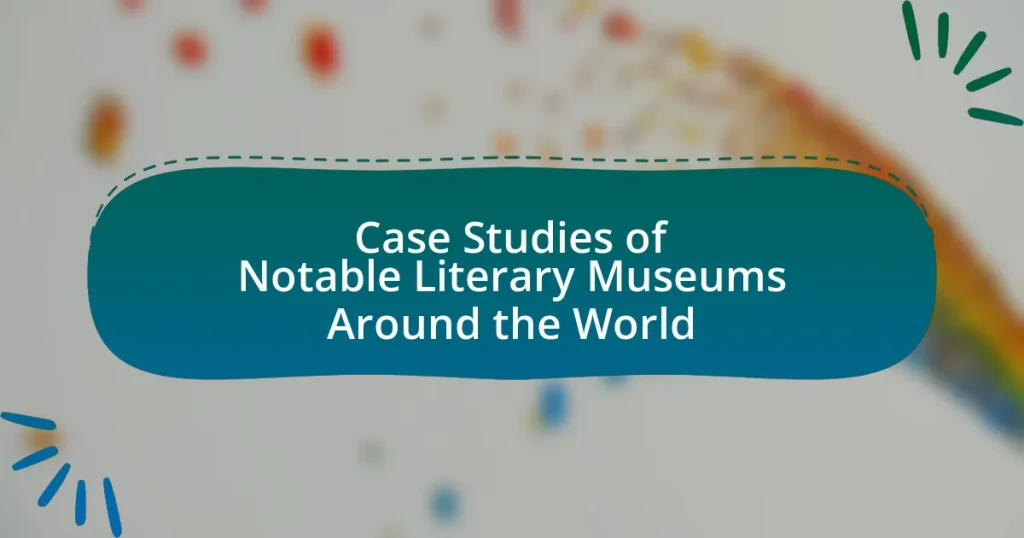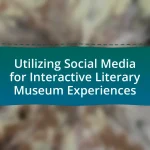Literary museums are dedicated institutions that preserve and interpret the lives and works of authors and literary figures, serving as cultural repositories that enhance the understanding of literature. This article examines notable literary museums worldwide, such as the Ernest Hemingway Home and Museum and the Charles Dickens Museum, highlighting their significance in cultural preservation, showcasing authors’ legacies, and engaging with local and global literary communities. It also explores the various types of literary museums, the visitor experiences they offer, and how they adapt to modern challenges through technology and educational collaborations. Key practices for visiting these museums are also discussed to enhance visitor engagement and appreciation of literary heritage.
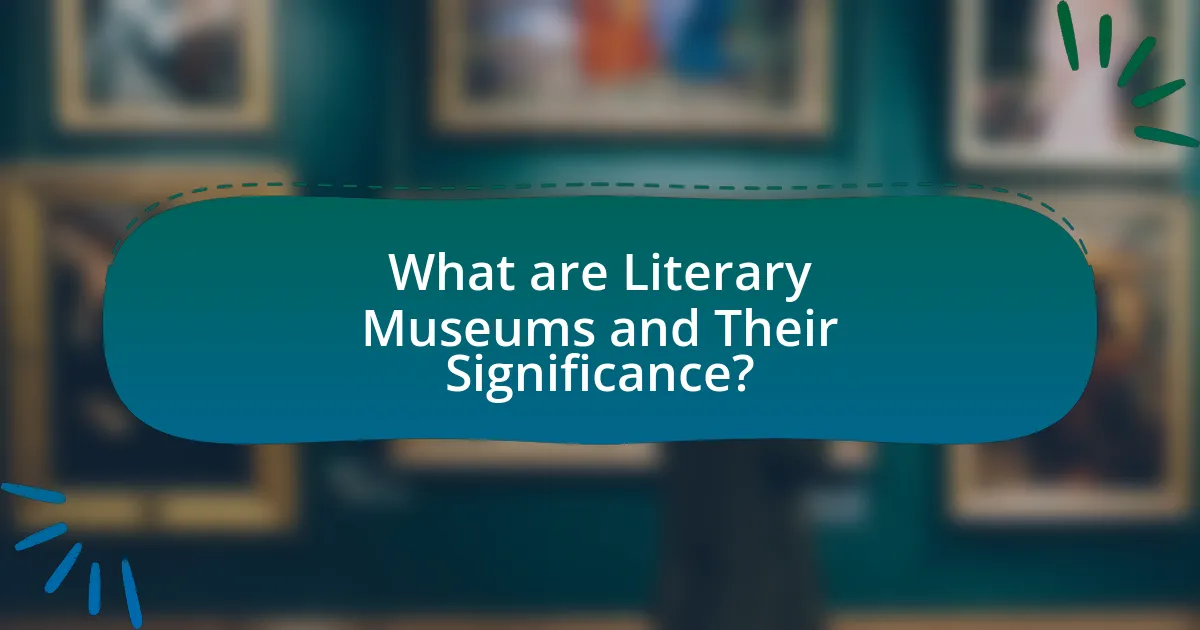
What are Literary Museums and Their Significance?
Literary museums are institutions dedicated to preserving, showcasing, and interpreting the lives and works of authors and literary figures. They serve as cultural repositories that provide insights into the historical context, creative processes, and personal stories of writers, thereby enriching the understanding of literature. For instance, the Ernest Hemingway Home and Museum in Key West, Florida, not only displays Hemingway’s personal belongings but also offers guided tours that highlight his literary contributions and the environment that influenced his writing. This significance lies in their role as educational resources, fostering appreciation for literature and its impact on society, while also attracting tourism and supporting local economies.
How do Literary Museums contribute to cultural preservation?
Literary museums contribute to cultural preservation by safeguarding the works, lives, and contexts of influential authors and literary movements. These institutions collect, curate, and display manuscripts, letters, personal artifacts, and other materials that provide insight into the literary heritage of a region or culture. For example, the Ernest Hemingway Home and Museum in Key West preserves Hemingway’s manuscripts and personal belongings, allowing visitors to engage with his life and work, thereby fostering an understanding of his impact on American literature. Additionally, literary museums often host educational programs, exhibitions, and events that promote awareness and appreciation of literary history, ensuring that future generations remain connected to their cultural roots.
What role do they play in showcasing authors’ legacies?
Literary museums play a crucial role in showcasing authors’ legacies by preserving their works, personal artifacts, and historical context. These institutions provide a physical space where visitors can engage with the life and contributions of authors, enhancing public understanding and appreciation of their literary significance. For instance, the Ernest Hemingway Home and Museum in Key West displays Hemingway’s personal belongings and manuscripts, allowing visitors to connect with his life experiences and literary output. This direct interaction with an author’s environment and materials fosters a deeper connection to their legacy, ensuring that their contributions to literature are remembered and celebrated.
How do they engage with local and global literary communities?
Literary museums engage with local and global literary communities through various initiatives such as hosting author readings, workshops, and exhibitions that celebrate literary heritage. For instance, the British Library in London collaborates with international authors and institutions to curate exhibitions that showcase global literary works, thereby fostering cross-cultural dialogue. Additionally, many literary museums participate in global literary festivals, which attract diverse audiences and promote literary exchange. These efforts not only enhance community involvement but also position the museums as vital hubs for literary discourse on both local and international scales.
What types of Literary Museums exist around the world?
Literary museums around the world can be categorized into several types, including author museums, literary heritage museums, and thematic museums. Author museums, such as the Ernest Hemingway Home and Museum in Key West, Florida, focus on the life and works of specific writers. Literary heritage museums, like the Charles Dickens Museum in London, preserve the history and context of literary movements and figures. Thematic museums, such as the Museum of Modern Literature in Germany, explore broader literary themes or genres, showcasing various authors and their contributions to literature. Each type serves to educate the public about literary history and the impact of literature on culture.
What distinguishes a house museum from a dedicated literary museum?
A house museum is primarily focused on preserving and showcasing the historical home of a specific individual, often reflecting their personal life and domestic environment, while a dedicated literary museum centers on the works, contributions, and legacy of a particular author or literary movement. House museums typically emphasize the architecture, furnishings, and artifacts related to the individual, whereas literary museums provide a broader context of the author’s literary impact, including manuscripts, letters, and thematic exhibitions related to their works. For example, the Ernest Hemingway Home and Museum in Key West highlights Hemingway’s life and personal belongings, while the British Library serves as a dedicated literary museum showcasing a vast collection of literary artifacts from various authors.
How do thematic museums focus on specific literary genres or movements?
Thematic museums focus on specific literary genres or movements by curating exhibits that highlight key authors, works, and historical contexts relevant to those genres or movements. For instance, a museum dedicated to the Romantic movement may showcase manuscripts, personal artifacts of poets like William Wordsworth and Samuel Taylor Coleridge, and interactive displays that explain the cultural and philosophical underpinnings of Romanticism. This targeted approach allows visitors to engage deeply with the specific literary themes, styles, and historical significance, enhancing their understanding of the genre or movement. Additionally, thematic museums often host events, lectures, and workshops that further explore the nuances of the literary focus, thereby enriching the visitor experience and fostering a community of literary enthusiasts.
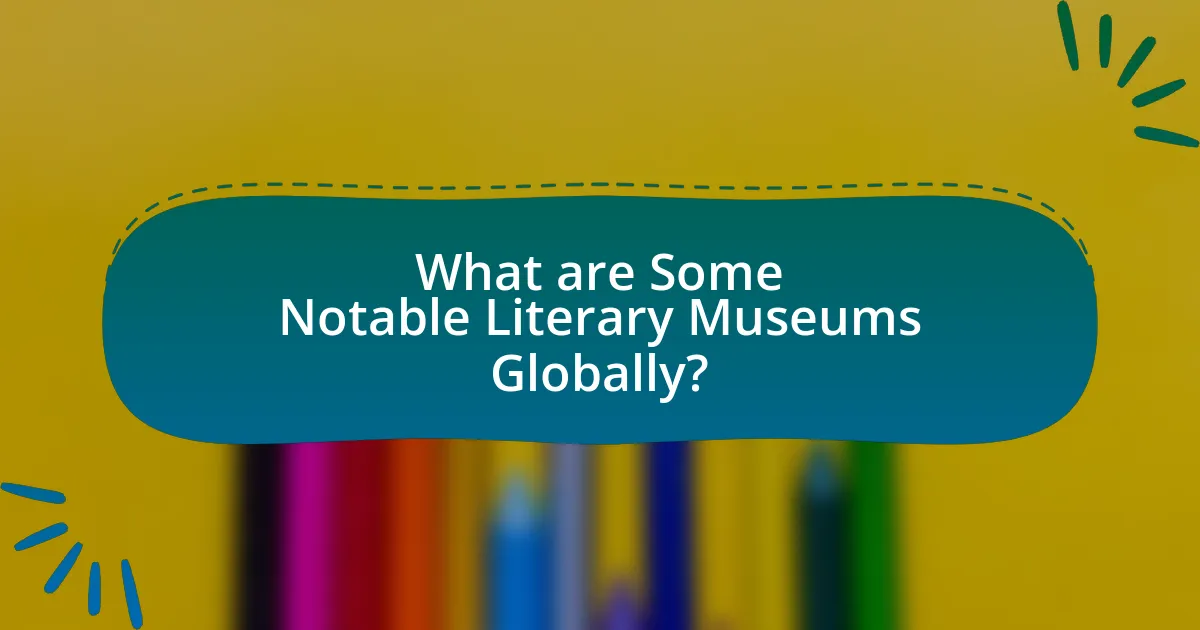
What are Some Notable Literary Museums Globally?
Some notable literary museums globally include the Ernest Hemingway Home and Museum in Key West, Florida, the Charles Dickens Museum in London, and the Museo Casa de la Literatura Peruana in Lima, Peru. The Ernest Hemingway Home and Museum showcases the life and works of the author, featuring his writing studio and personal artifacts. The Charles Dickens Museum, located in Dickens’ former residence, offers insights into his life and literary contributions, housing original manuscripts and personal items. The Museo Casa de la Literatura Peruana celebrates Peruvian literature and authors, providing exhibitions and educational programs that highlight the country’s literary heritage.
Which museums are recognized for their unique collections?
The British Museum is recognized for its unique collection of world art and artifacts, including the Rosetta Stone and the Elgin Marbles. The Louvre Museum is also notable for its extensive collection of art, including the Mona Lisa and the Venus de Milo. Additionally, the Smithsonian Institution houses diverse collections across multiple museums, including the National Museum of American History, which showcases artifacts like the original Star-Spangled Banner. Each of these museums is distinguished by their significant and historically important collections that attract millions of visitors annually.
What makes the British Library a significant literary museum?
The British Library is a significant literary museum due to its extensive collection of over 170 million items, including rare manuscripts, historical documents, and literary works. This vast repository includes original manuscripts by authors such as William Shakespeare, Jane Austen, and Charles Dickens, which provide invaluable insights into literary history. Additionally, the library houses the Magna Carta and the Gutenberg Bible, underscoring its role as a custodian of cultural heritage. Its commitment to preserving and providing access to these materials makes it a vital institution for researchers, scholars, and the public, reinforcing its status as a premier literary museum globally.
How does the Ernest Hemingway Home and Museum reflect the author’s life?
The Ernest Hemingway Home and Museum reflects the author’s life through its preservation of his personal belongings, writing environment, and the architecture of the house itself. The museum, located in Key West, Florida, showcases Hemingway’s writing studio, where he produced significant works such as “A Farewell to Arms” and “For Whom the Bell Tolls.” The house features original furnishings, photographs, and memorabilia that illustrate his lifestyle, interests, and relationships, including his love for cats, which are still present on the property. Additionally, the museum’s gardens and the surrounding environment highlight Hemingway’s connection to nature and his experiences in Florida, further emphasizing the influence of his surroundings on his literary output.
What are the visitor experiences like at these museums?
Visitor experiences at notable literary museums are often immersive and educational, allowing guests to engage deeply with the lives and works of renowned authors. Many museums feature interactive exhibits, guided tours, and special events that enhance understanding of literary history. For instance, the Charles Dickens Museum in London offers a glimpse into Dickens’ life through his personal artifacts and manuscripts, while the Ernest Hemingway Home and Museum in Key West provides insights into Hemingway’s writing process and personal life through preserved rooms and guided storytelling. These experiences are designed to foster a connection between visitors and the literary figures, making the museums not just places of display but also centers of cultural engagement and learning.
How do guided tours enhance the understanding of literary works?
Guided tours enhance the understanding of literary works by providing contextual insights and expert interpretations that deepen appreciation. These tours often include discussions about the author’s life, historical background, and the cultural significance of the works, which can illuminate themes and motifs that may not be immediately apparent to readers. For example, a guided tour at the Ernest Hemingway Home and Museum in Key West offers visitors a chance to explore Hemingway’s personal artifacts and the environment that influenced his writing, thereby enriching their comprehension of his literary contributions. Such immersive experiences facilitate a more nuanced understanding of the texts, as they connect literature to its real-world context and the author’s intentions.
What interactive exhibits are commonly found in literary museums?
Literary museums commonly feature interactive exhibits such as digital storytelling stations, immersive reading rooms, and author-themed escape rooms. Digital storytelling stations allow visitors to engage with literary works through multimedia presentations, enhancing their understanding of the narratives. Immersive reading rooms create environments that reflect the settings of famous literary works, encouraging visitors to experience the stories in a tangible way. Author-themed escape rooms challenge participants to solve puzzles related to an author’s life or works, fostering a deeper connection to the literature. These interactive elements are designed to enhance visitor engagement and education, making literature accessible and enjoyable.
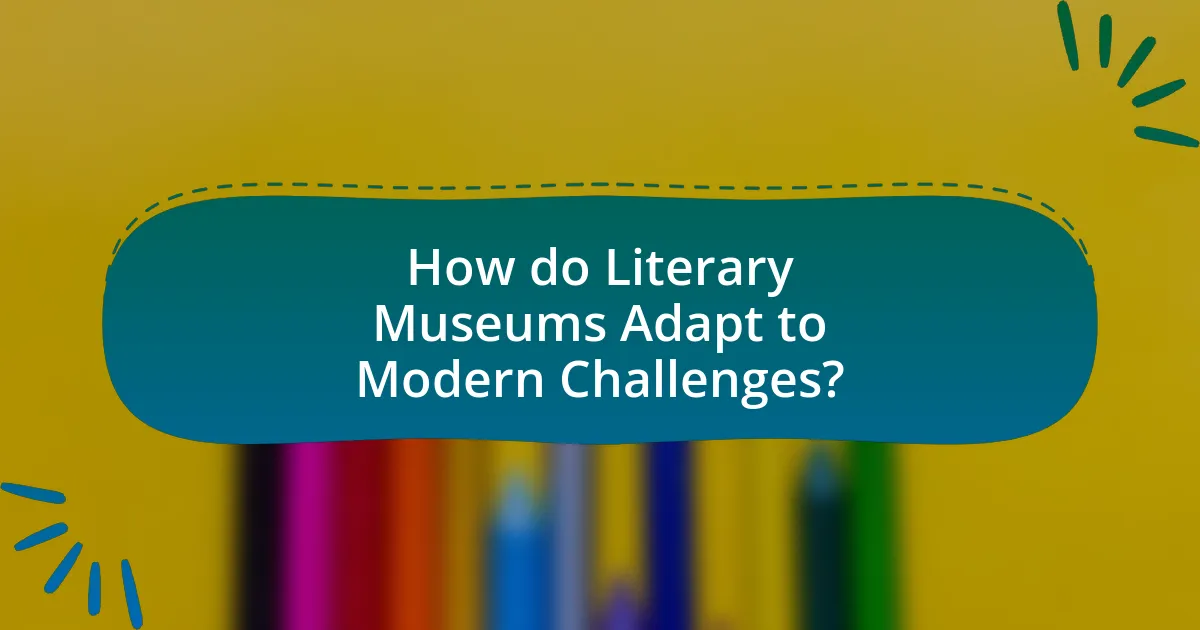
How do Literary Museums Adapt to Modern Challenges?
Literary museums adapt to modern challenges by integrating technology, enhancing visitor engagement, and diversifying their programming. For instance, many museums now offer virtual tours and interactive exhibits that utilize augmented reality to attract a broader audience. The British Library has implemented digital archives, allowing global access to its collections, which increases its reach and relevance. Additionally, literary museums are hosting events such as author talks, workshops, and community outreach programs to foster a deeper connection with diverse demographics. These strategies not only address the decline in physical attendance but also respond to changing visitor expectations in the digital age.
What strategies do museums use to attract younger audiences?
Museums attract younger audiences through interactive exhibits, digital engagement, and social media marketing. Interactive exhibits, such as hands-on activities and immersive experiences, encourage participation and learning, making visits more appealing to younger demographics. Digital engagement includes virtual tours and mobile apps that enhance the visitor experience, allowing for exploration beyond physical boundaries. Social media marketing leverages platforms like Instagram and TikTok to reach younger audiences, showcasing events and exhibits in visually engaging formats. For instance, the American Museum of Natural History reported a 30% increase in attendance among visitors aged 18-24 after implementing these strategies.
How do digital technologies enhance the visitor experience?
Digital technologies enhance the visitor experience by providing interactive and immersive engagement opportunities. For instance, virtual reality (VR) allows visitors to explore literary settings and historical contexts in a way that traditional exhibits cannot, creating a more memorable experience. Additionally, augmented reality (AR) applications can overlay digital information onto physical exhibits, enriching the understanding of artifacts and narratives. A study by the American Alliance of Museums found that 70% of visitors reported increased satisfaction when digital tools were integrated into their museum experience, demonstrating the effectiveness of these technologies in enhancing visitor engagement and learning.
What role do social media platforms play in promoting literary museums?
Social media platforms play a crucial role in promoting literary museums by enhancing visibility and engagement with diverse audiences. These platforms allow literary museums to share multimedia content, such as virtual tours, author interviews, and event announcements, which can attract a wider audience. For instance, the British Library utilizes Twitter and Instagram to showcase rare manuscripts and promote exhibitions, resulting in increased foot traffic and online engagement. Additionally, social media facilitates community interaction, enabling museums to connect with literary enthusiasts and foster discussions around literature, thereby enriching the cultural landscape.
How do Literary Museums collaborate with educational institutions?
Literary museums collaborate with educational institutions by developing programs that enhance literary education and promote cultural literacy. These collaborations often include joint workshops, curriculum development, and educational resources that align with school standards. For example, the British Library partners with schools to provide access to primary sources and educational materials, facilitating hands-on learning experiences that deepen students’ understanding of literature and history. Additionally, literary museums frequently host student field trips, offering guided tours and interactive exhibits that engage young learners and foster a love for literature.
What programs are designed for school groups and students?
Literary museums around the world offer various educational programs specifically designed for school groups and students. These programs often include guided tours, interactive workshops, and curriculum-based activities that align with educational standards. For instance, the British Museum provides tailored educational sessions that engage students with artifacts and literature, while the Mark Twain House & Museum offers programs that explore Twain’s life and works through hands-on activities. Such initiatives are aimed at enhancing students’ understanding of literature and history, fostering a deeper appreciation for the arts.
How do partnerships with universities enhance literary scholarship?
Partnerships with universities enhance literary scholarship by facilitating collaborative research, access to academic resources, and the integration of diverse perspectives. These collaborations often lead to joint projects that produce new insights into literary works and authors, as seen in initiatives like the University of Oxford’s partnership with the Bodleian Library, which has resulted in significant archival research and public exhibitions. Furthermore, university partnerships provide literary museums with access to scholarly expertise and funding opportunities, enabling them to host lectures, workshops, and conferences that promote literary discourse and scholarship.
What are best practices for visiting Literary Museums?
Best practices for visiting literary museums include planning your visit in advance, engaging with guided tours, and respecting museum etiquette. Planning allows visitors to check for special exhibitions, events, or guided tours that enhance the experience. Engaging with guided tours provides deeper insights into the authors’ lives and works, as these tours often include expert commentary and access to exclusive areas. Respecting museum etiquette, such as refraining from touching exhibits and maintaining a quiet atmosphere, ensures a pleasant experience for all visitors. These practices enhance understanding and appreciation of the literary heritage showcased in these museums.
How can visitors prepare for an enriching experience at literary museums?
Visitors can prepare for an enriching experience at literary museums by researching the authors and literary movements represented in the museum. Understanding the historical context and significance of the works displayed enhances appreciation and engagement. For instance, knowing that the Ernest Hemingway Home and Museum in Key West showcases the author’s life and writing process can deepen visitors’ insights into his literary contributions. Additionally, reviewing the museum’s website for special exhibitions, guided tours, and educational programs can help visitors plan their visit effectively, ensuring they maximize their experience.
What etiquette should be observed while visiting these cultural sites?
Visitors to cultural sites, particularly literary museums, should observe several key etiquette practices. First, maintaining a respectful demeanor is essential; this includes speaking softly and refraining from disruptive behavior, as many visitors seek a contemplative atmosphere. Additionally, photography policies must be adhered to; some museums prohibit flash photography or the use of cameras altogether to protect artifacts. Visitors should also refrain from touching exhibits unless explicitly permitted, as this helps preserve the integrity of the items on display. Furthermore, it is courteous to follow any guidelines provided by museum staff, as they are in place to ensure a positive experience for all. Observing these etiquettes not only enhances the visitor experience but also honors the cultural significance of the sites.
